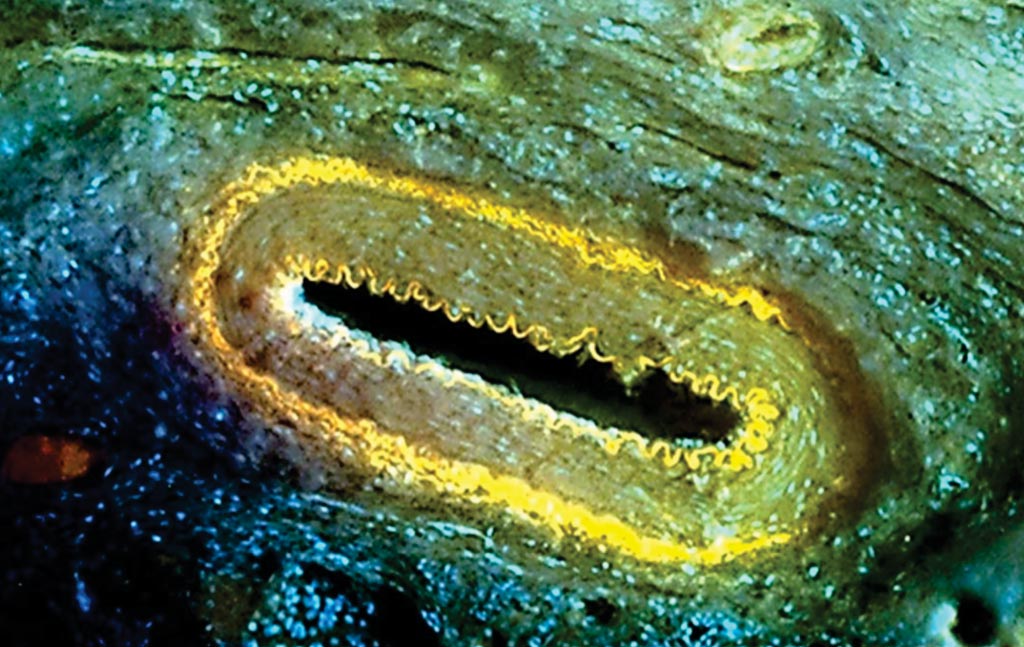Ultraviolet Surface Excitation Microscopy Emerges as Diagnostic Tool
|
By LabMedica International staff writers Posted on 21 Dec 2017 |

Image: MUSE photograph of a renal artery with internal and external elastic lamina; the microscope uses ultraviolet light to illuminate samples enables pathologists to assess high-resolution images of biopsies and other fresh tissue samples for disease within minutes, without requiring the time-consuming preparation of conventional slides or destroying the tissue (Photo courtesy of MUSE Microscopy).
Histological examination of tissues is central to the diagnosis and management of neoplasms and many other diseases and is a foundational technique for preclinical and basic studies.
Commonly used bright-field microscopy requires prior preparation of micrometer-thick tissue sections mounted on glass slide which is a process that can require hours or days, contributes to cost and delays access to critical information.
Laboratory scientists at University of California Davis Medical Center (Sacramento, CA, USA) have developed a simple, non-destructive slide-free technique that, within minutes, provides high-resolution diagnostic histological images resembling those obtained from conventional hematoxylin and eosin histology. The approach, which they named microscopy with ultraviolet surface excitation (MUSE), can also generate shape and color-contrast information. MUSE relies on ~280 nm ultraviolet light to restrict the excitation of conventional fluorescent stains to tissue surfaces and it has no significant effects on downstream molecular assays (including fluorescence in situ hybridization and RNA sequencing).
Samples that have been stained with eosin or other standard dyes to highlight important features such as nuclei, cytoplasm and extracellular components produce signals from the UV excitation that are bright enough to be detected by conventional color cameras using sub-second exposure times. The process allows for rapid imaging of large areas and immediate interpretation. MUSE's ability to quickly gather high-resolution images without consuming the tissue is an especially important feature. The technology is being commercialized by MUSE Microscopy Inc (Davis, CA, USA).
Richard Levenson, MD, FCAP, professor and vice chair for strategic technologies in the Department of Pathology and Laboratory Medicine at UC Davis and senior author of the study, said, “MUSE eliminates any need for conventional tissue processing with formalin fixation, paraffin embedding or thin-sectioning. It doesn't require lasers, confocal, multiphoton or optical coherence tomography instrumentation, and the simple technology makes it well suited for deployment wherever biopsies are obtained and evaluated.” The study was published on December 4, 2017, in the journal Nature Biomedical Engineering.
Related Links:
University of California Davis Medical Center
MUSE Microscopy
Commonly used bright-field microscopy requires prior preparation of micrometer-thick tissue sections mounted on glass slide which is a process that can require hours or days, contributes to cost and delays access to critical information.
Laboratory scientists at University of California Davis Medical Center (Sacramento, CA, USA) have developed a simple, non-destructive slide-free technique that, within minutes, provides high-resolution diagnostic histological images resembling those obtained from conventional hematoxylin and eosin histology. The approach, which they named microscopy with ultraviolet surface excitation (MUSE), can also generate shape and color-contrast information. MUSE relies on ~280 nm ultraviolet light to restrict the excitation of conventional fluorescent stains to tissue surfaces and it has no significant effects on downstream molecular assays (including fluorescence in situ hybridization and RNA sequencing).
Samples that have been stained with eosin or other standard dyes to highlight important features such as nuclei, cytoplasm and extracellular components produce signals from the UV excitation that are bright enough to be detected by conventional color cameras using sub-second exposure times. The process allows for rapid imaging of large areas and immediate interpretation. MUSE's ability to quickly gather high-resolution images without consuming the tissue is an especially important feature. The technology is being commercialized by MUSE Microscopy Inc (Davis, CA, USA).
Richard Levenson, MD, FCAP, professor and vice chair for strategic technologies in the Department of Pathology and Laboratory Medicine at UC Davis and senior author of the study, said, “MUSE eliminates any need for conventional tissue processing with formalin fixation, paraffin embedding or thin-sectioning. It doesn't require lasers, confocal, multiphoton or optical coherence tomography instrumentation, and the simple technology makes it well suited for deployment wherever biopsies are obtained and evaluated.” The study was published on December 4, 2017, in the journal Nature Biomedical Engineering.
Related Links:
University of California Davis Medical Center
MUSE Microscopy
Latest Pathology News
- Sensitive and Specific DUB Enzyme Assay Kits Require Minimal Setup Without Substrate Preparation
- World’s First AI Model for Thyroid Cancer Diagnosis Achieves Over 90% Accuracy
- Breakthrough Diagnostic Approach to Significantly Improve TB Detection
- Rapid, Ultra-Sensitive, PCR-Free Detection Method Makes Genetic Analysis More Accessible
- Spit Test More Accurate at Identifying Future Prostate Cancer Risk
- DNA Nanotechnology Boosts Sensitivity of Test Strips
- Novel UV and Machine Learning-Aided Method Detects Microbial Contamination in Cell Cultures
- New Error-Corrected Method to Help Detect Cancer from Blood Samples Alone
- "Metal Detector" Algorithm Hunts Down Vulnerable Tumors
- Novel Technique Uses ‘Sugar’ Signatures to Identify and Classify Pancreatic Cancer Cell Subtypes
- Advanced Imaging Reveals Mechanisms Causing Autoimmune Disease
- AI Model Effectively Predicts Patient Outcomes in Common Lung Cancer Type
- AI Model Predicts Patient Response to Bladder Cancer Treatment
- New Laser-Based Method to Accelerate Cancer Diagnosis
- New AI Model Predicts Gene Variants’ Effects on Specific Diseases
- Powerful AI Tool Diagnoses Coeliac Disease from Biopsy Images with Over 97% Accuracy
Channels
Clinical Chemistry
view channel
‘Brilliantly Luminous’ Nanoscale Chemical Tool to Improve Disease Detection
Thousands of commercially available glowing molecules known as fluorophores are commonly used in medical imaging, disease detection, biomarker tagging, and chemical analysis. They are also integral in... Read more
Low-Cost Portable Screening Test to Transform Kidney Disease Detection
Millions of individuals suffer from kidney disease, which often remains undiagnosed until it has reached a critical stage. This silent epidemic not only diminishes the quality of life for those affected... Read more
New Method Uses Pulsed Infrared Light to Find Cancer's 'Fingerprints' In Blood Plasma
Cancer diagnoses have traditionally relied on invasive or time-consuming procedures like tissue biopsies. Now, new research published in ACS Central Science introduces a method that utilizes pulsed infrared... Read moreMolecular Diagnostics
view channel
New Blood Test Detects 12 Common Cancers Before Symptoms Appear
Bowel cancer is the fourth most common cancer in the UK, with over 42,000 new diagnoses each year. Detecting bowel cancer in its early stages can be challenging, and as the disease progresses, survival... Read more
Blood Test Could Predict Relapse of Autoimmune Blood Vessel Disease
Neutrophils, once believed to be uniform in nature, have been discovered to exhibit significant diversity. These immune cells, which play a crucial role in fighting infections, are also implicated in autoimmune... Read moreHematology
view channel
New Scoring System Predicts Risk of Developing Cancer from Common Blood Disorder
Clonal cytopenia of undetermined significance (CCUS) is a blood disorder commonly found in older adults, characterized by mutations in blood cells and a low blood count, but without any obvious cause or... Read more
Non-Invasive Prenatal Test for Fetal RhD Status Demonstrates 100% Accuracy
In the United States, approximately 15% of pregnant individuals are RhD-negative. However, in about 40% of these cases, the fetus is also RhD-negative, making the administration of RhoGAM unnecessary.... Read moreImmunology
view channel
Stem Cell Test Predicts Treatment Outcome for Patients with Platinum-Resistant Ovarian Cancer
Epithelial ovarian cancer frequently responds to chemotherapy initially, but eventually, the tumor develops resistance to the therapy, leading to regrowth. This resistance is partially due to the activation... Read more
Machine Learning-Enabled Blood Test Predicts Immunotherapy Response in Lymphoma Patients
Chimeric antigen receptor (CAR) T-cell therapy has emerged as one of the most promising recent developments in the treatment of blood cancers. However, over half of non-Hodgkin lymphoma (NHL) patients... Read moreMicrobiology
view channel
Handheld Device Delivers Low-Cost TB Results in Less Than One Hour
Tuberculosis (TB) remains the deadliest infectious disease globally, affecting an estimated 10 million people annually. In 2021, about 4.2 million TB cases went undiagnosed or unreported, mainly due to... Read more
New AI-Based Method Improves Diagnosis of Drug-Resistant Infections
Drug-resistant infections, particularly those caused by deadly bacteria like tuberculosis and staphylococcus, are rapidly emerging as a global health emergency. These infections are more difficult to treat,... Read more
Breakthrough Diagnostic Technology Identifies Bacterial Infections with Almost 100% Accuracy within Three Hours
Rapid and precise identification of pathogenic microbes in patient samples is essential for the effective treatment of acute infectious diseases, such as sepsis. The fluorescence in situ hybridization... Read moreTechnology
view channel
Disposable Microchip Technology Could Selectively Detect HIV in Whole Blood Samples
As of the end of 2023, approximately 40 million people globally were living with HIV, and around 630,000 individuals died from AIDS-related illnesses that same year. Despite a substantial decline in deaths... Read more
Pain-On-A-Chip Microfluidic Device Determines Types of Chronic Pain from Blood Samples
Chronic pain is a widespread condition that remains difficult to manage, and existing clinical methods for its treatment rely largely on self-reporting, which can be subjective and especially problematic... Read more
Innovative, Label-Free Ratiometric Fluorosensor Enables More Sensitive Viral RNA Detection
Viruses present a major global health risk, as demonstrated by recent pandemics, making early detection and identification essential for preventing new outbreaks. While traditional detection methods are... Read moreIndustry
view channel
Cepheid and Oxford Nanopore Technologies Partner on Advancing Automated Sequencing-Based Solutions
Cepheid (Sunnyvale, CA, USA), a leading molecular diagnostics company, and Oxford Nanopore Technologies (Oxford, UK), the company behind a new generation of sequencing-based molecular analysis technologies,... Read more
Grifols and Tecan’s IBL Collaborate on Advanced Biomarker Panels
Grifols (Barcelona, Spain), one of the world’s leading producers of plasma-derived medicines and innovative diagnostic solutions, is expanding its offer in clinical diagnostics through a strategic partnership... Read more





















